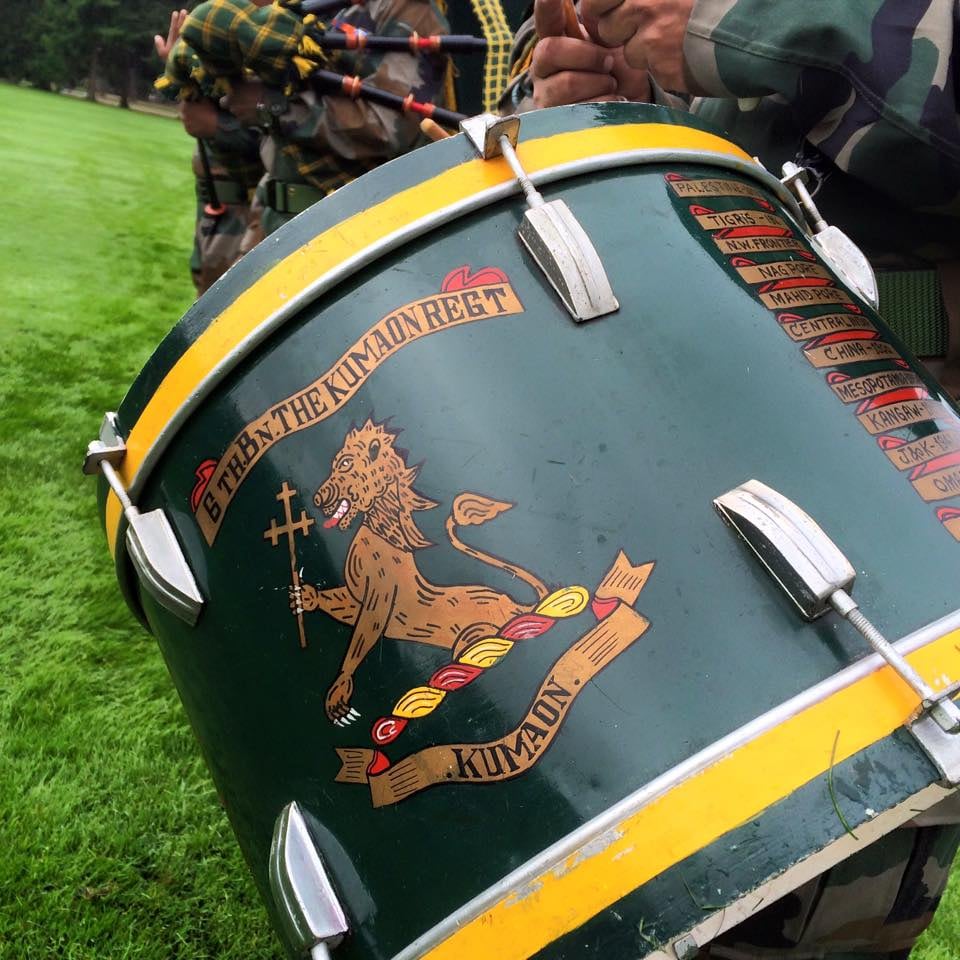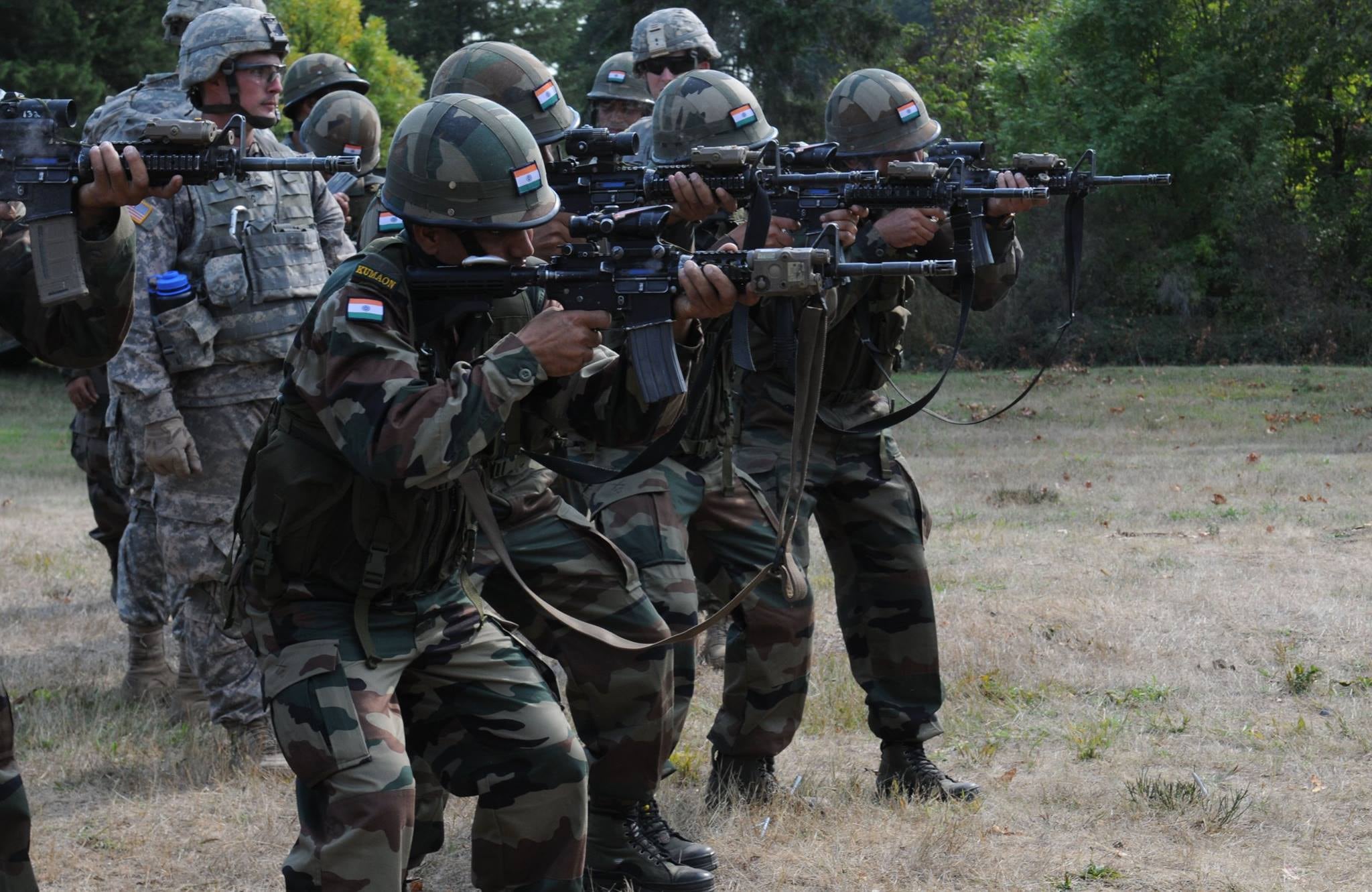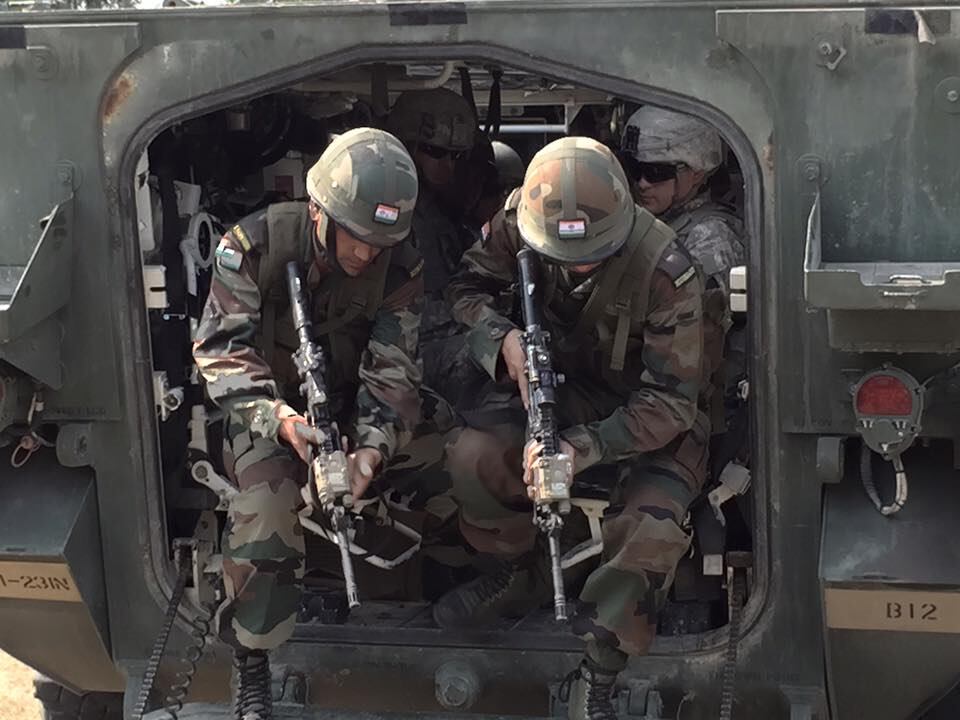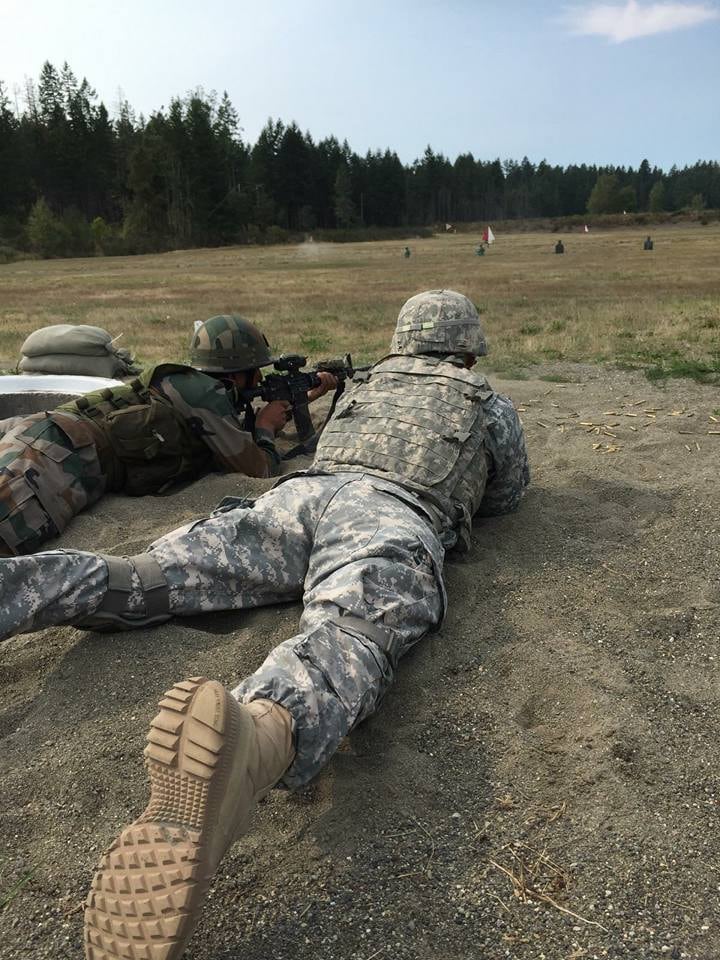As they prepared to welcome about 150 Indian Army soldiers to their installation for the first time, the soldiers at Joint Base Lewis-McChord, Washington, didn't know what to expect.
"A lot of guys had worked with the Iraqis and the Afghans, and the attitude was 'we're going to have to teach them and hold their hands,' but it's been the opposite," said Sgt. 1st Class Michael Zehring, the platoon sergeant for 1st Platoon, B Company, 1st Battalion, 23rd Infantry Regiment. "These guys are well trained, they're highly motivated. They can do anything we ask them to do or that we show them to do because that's how they already do things."
The Indian Army soldiers are at Joint Base Lewis-McChord for Exercise Yudh Abhyas, an annual bilateral exercise between India and the United States. This is the first time the exercise, which is in its 11th year, has taken place on Joint Base Lewis-McChord.
The Indian soldiers, from the 9th Mountain Brigade and its subordinate 6th Kumaon Battalion, arrived right around Labor Day, and they will be on post until Sept. 23, when the exercise culminates with a company-level live-fire field training exercise.
While they're in the U.S., they are training and working alongside soldiers from 1st Battalion, 23rd Infantry, which is part of the newly renamed 1st Stryker Brigade Combat Team, 2nd Infantry Division. The brigade, which is assigned to the 7th Infantry Division at JBLM, previously was known as 3rd SBCT, 2nd Infantry Division.
The exercise with the Indians, which takes place during the even years in India and during the odd years in the U.S., is at JBLM this year to reinforce the Army's focus on the Pacific, said Brig. Gen. Rob Ulses, deputy commanding general for support for the 7th Infantry Division.
"We have forces assigned here who work the Pacific [area of operations], and with the rebalance to the Pacific, I think [Army leaders] wanted to showcase that," Ulses said.

Indian Army troops from the 6th Battalion of the Kumaon Regiment during Yudh Abhyas 15 at Joint Base Lewis-McChord, Wash.
Photo Credit: Army
In addition to the Indians, JBLM also is playing host to about 400 Japanese soldiers for the annual Rising Thunder exercise. The training, at Yakima Training Area, allows the Japanese room to maneuver their big vehicles and weapon systems, Ulses said.
"They, more than Yudh Abhyas, drive the training that's conducted so they can get what they need out of the training, but we use it as an opportunity to work on interoperability and our relationship," Ulses said.
The Japanese soldiers are training alongside a battalion of soldiers from 2nd SBCT, 2nd Infantry Division, and they're working on combined arms maneuver training, Ulses said.
"It's very unique that we have both the Japanese and Indian armies here," Ulses said. "It demonstrates the rebalance to the Pacific, but it also strengthens our capabilities and interoperability. For instance, if something were to happen, whether it's a shooting crisis or humanitarian crisis, we would have already done this exchange and we're not learning on the fly. We're building trust and confidence with our partners."
The Indian soldiers flew into JBLM on their own C-17 carrying their own equipment, Ulses said.
While they're in the U.S., they will simultaneously conduct a command post exercise that focuses on running a United Nations peacekeeping operation at the brigade level, a field training exercise focusing on counter-insurgency operations, and expert academic discussions on topics such as regional security, emerging challenges and the Army operating concept.
Since the exercise's opening ceremony on Sept. 9, the soldiers have been working on individual, team and squad level training.

Indian Army troops from the 6th Battalion of the Kumaon Regiment participate in drills during Yudh Abhyas 15 on Sept. 11 at Joint Base Lewis-McChord, Wash.
Photo Credit: Sgt. Sinthia Rosario/Army
The soldiers are focusing on weapons training, small unit tactical training and leader development, mixing classroom instruction with time on the range or in the field, said Lt. Col. Teddy Kleisner, commander of 1st Battalion, 23rd Infantry.
The goal is to prepare them for the company-level culminating event, where the soldiers will be required to conduct a cordon and search operation to seize high-value targets in a contested town as part of a major peacekeeping operation, Kleisner said.
On a typical day, the American soldiers show up at 6 a.m. to conduct physical fitness training with the Indians, Zehring said.
"So far we've played soccer, ultimate football, we've run – they're excellent runners," he said.
The soldiers then reconvene at 9 a.m. to begin the day's training, he said.
The soldiers have shot each other's weapons – the Indian Army uses the INSAS rifle.
The Indians were also very interested in the Stryker, which is a vehicle they don't have, Zehring said.
"They were very interested in spare tires, and I only say that because about 15 people asked about spare tires," he said. "I have a feeling if they have wheeled vehicles, they get flat tires quite a bit."
The Indians enjoyed learning about the Stryker's weapon systems and how an infantry unit can fight from the vehicle or use it as a rolling platform for cover and concealment, Zehring said.

Indian Army troops from the 6th Battalion of the Kumaon Regiment drill during Yudh Abhyas 15 at Joint Base Lewis-McChord, Wash.
Photo Credit: Army
The two infantry units have not had too much trouble integrating, even with a language barrier, particularly among the enlisted soldiers, Kleisner said.
"Because they're a competent army, when we say, 'hey, we're going to go seize this house,' we don't have to discuss it too much because they know what seizing a house looks like, and we know what seizing a house looks like," he said. "It's been cool to see it all come together."
It has also been easy to operate together, Kleisner said.
"Interoperability is actually easier at the tactical level," he said. "You see two different types of rifles, but they shoot the same type of ammo. To us, that's interoperable. Our tactics are interoperable, how we shoot, move and communicate."
Where issues could arise, potentially, is if the two units were to share communications equipment, Kleisner said, adding that for this exercise the Indians will use American equipment.
The Indian Army also doesn't commonly use night-vision goggles, which could translate into different considerations when planning operations.
"Night vision devices proliferate in our formations. For them, that is not the case," Kleisner said. "We've seen the difference in decision-making. Where we'd say we'd go in under the cover of darkness, they would come in a first light."
So far, the Indian soldiers have defied the soldiers' expectations.
"What's great for us to see is the general level of competence that we see in the Indian Army," Kleisner said. "It increases the amount of trust we have in them as future partners. It's good for us as a unit to experience this. We all have experience with the Iraqi and Afghan armies, where we trained them from the ground floor."
Outside of work, the Indian and American soldiers have been enjoying cultural exchanges and team-building events.
"Soldier to soldier, that's a great way to exchange culture and develop friendships and partnerships," Ulses said.
Despite some initial uncertainty or language barriers, it has not been difficult to integrate the Indians with the American soldiers, Ulses said.
"Quite frankly, when you're dealing with soldiers, soldiers kind of speak a universal language," he said. "Soldiering is soldiering."
The Indian soldiers are staying on post, and the Americans have been making sure they're well taken care of, Kleisner said. This includes visiting nearby Ruby Beach and catching a Seattle Mariners game or spending time on post.
"And I know throughout the ranks people are trading things," Zehring said. "Patches for patches, Leathermans for Army knives from the Indians. It's what the boys do."
The Indians also are sharing some of their culture – since they are eating at the brigade's dining facility on post, they brought one of their cooks, their own spices and some jasmine rice.
"They're able to augment our chow hall to make sure things are not excessively bland," Kleisner said. "It's been cool for our cooks to get that side of the training. It's some of the fun things on the side we have going on."

U.S. Soldiers with the 3rd Brigade, 2nd Infantry Division and Indian Army troops from the 6th Battalion of the Kumaon Regiment, discuss tactics learned during close quarter battle drills during Yudh Abhyas 15 at Joint Base Lewis-McChord, Wash., Sept. 11. Yudh Abhyas is a joint U.S.-Indian Army bilateral Theater Security Cooperation Program exercise that provides both the U.S. and Indian Armies the opportunity to share combat experiences and skills.
Photo Credit: Army
So far, the feedback from his soldiers as well as the Indians has been positive, Kleisner said.
"There's definitely positive rapport between our ranks," he said. "We're impressed with their level of tactical competence, and they're impressed with our level of leader empowerment."
The Indian officers have already remarked about the role noncommissioned officers play in the U.S. Army, Kleisner said.
"Their NCOs seem competent, and they want to take the initiative, but I think they're just not empowered like ours are," he said.
Kleisner said his soldiers are learning lessons that will boost their ability to work with foreign partners.
"As an expeditionary Army, an Army that's going to deploy and work with international partners, this is giving us an opportunity to rehearse our integration with a foreign unit … so these aren't lessons we have to learn when we end up in combat with a foreign partner," he said. "What we'll end up doing is take a lot of lessons from this that will help us no matter where we go."
Michelle Tan is the editor of Army Times and Air Force Times. She has covered the military for Military Times since 2005, and has embedded with U.S. troops in Iraq, Afghanistan, Kuwait, Haiti, Gabon and the Horn of Africa.





